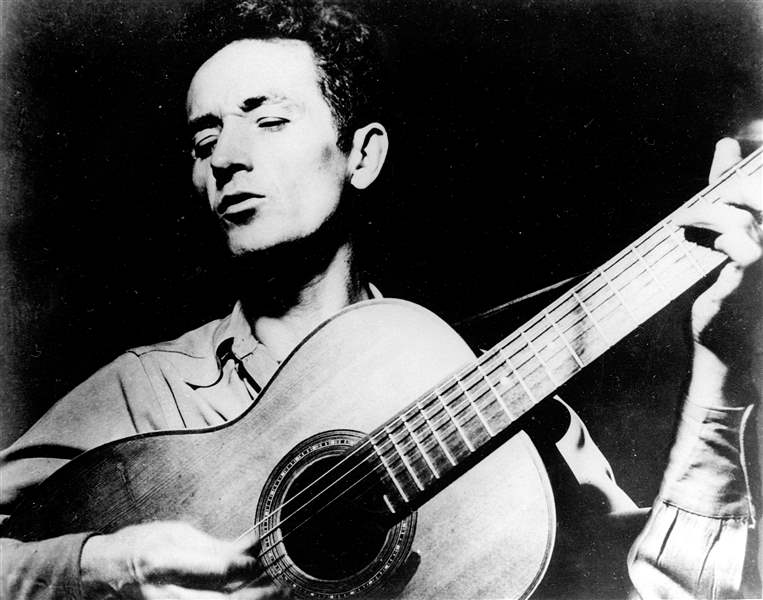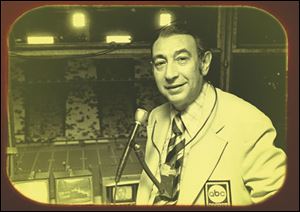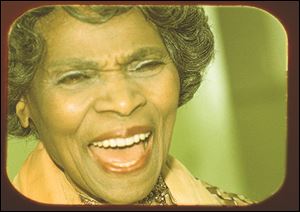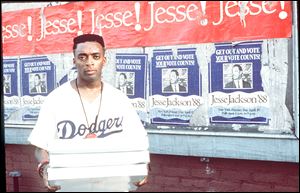
View from the 20th century
11/5/2017
Woody Guthrie
ASSOCIATED PRESS
Not even 20 years removed from our calendars, the 20th century is in danger of being forgotten and lost to a 21st-century generation only in touch with the now.
Touchstones that once defined popular culture can no longer compete with the blitzkrieg of trends, names, images, and, yes, cat videos that bombard Millennials seemingly every minute of every hour of every day through traditional and now social media.
It's no wonder that the proverbial “kids today” can’t keep up with the youth culture of Generation X and Baby Boomers.
This panel of popular culture experts of six Gen-Xers and one Baby Boomer met for a recent weeknight dinner in Bowling Green to discuss cultural touchstones that defined the 20th century, but are lost on a generation all about the 21st century.
Ms. Esther Clinton, visiting assistant professor of popular culture at Bowling Green State University
Matt Donahue, lecturer of popular culture at Bowling Green State University
Trinidad Linares, popular culture graduate student at Bowling Green State University
Montana Miller, associate professor of popular culture at Bowling Green State University
Tim Panek, clerk (and pop culture aficionado) at Sanger Branch Library in West Toledo
Jack Santino, professor of popular culture at Bowling Green State University
Jeremy Wallach, professor of popular culture at Bowling Green State University
Montana Miller, associate professor of popular culture at Bowling Green State University, has noticed this trend for a while.
"With the over-saturation of content that our students now are exposed to, as they have everything in the world at their fingertips through so many media channels now, it is easy for them to never even come across some of the cultural touchstones — artistically, musically, cinematically — that many of their professors simply grew up taking for granted as formative influences on the popular culture of previous decades."
“In their view,” Ms. Miller added, these touchstones “may not even be relevant! But if we have an opportunity to expose them to a couple of key artists/works, what would we choose? And maybe more important, what should we be aware that they are UNAWARE of, so that we don’t blithely throw out references to names, places, songs, and stories that don’t even ring a bell in our students’ smartphone-synced brains?”
With that in mind, we asked some local experts to help us formulate a starter guide to some of the important but not-so-obvious people, things, and events of the last century for a group perhaps born in the 20th century but too young to ever truly understand it.
This Is Spinal Tap. Cult-classic mockumentary about an aging rock band starring Christopher Guest, Michael McKean, Harry Shearer, and Rob Reiner, who also directed.
Jeremy Wallach: This movie not only reveals much about the music biz in the early 80s, it is a harbinger of 21st-century comedy driven by improvisation, genre parody, and outrageous characters. It also contains some of the most durable sayings and running gags of the century, from “these go to 11” to Stonehenge to the exploding drummer.
Master of Puppets. Released in 1986, Metallica’s seminal third album changed the band, heavy metal, and music.
Mr. Wallach: It is sometimes difficult to convey just how important rock music was for young people in the late 20th century. This brutal, uncompromising metal masterpiece is as crucial as popular music gets. A fiery indictment of adult-world hypocrisy and venality, Metallica’s music alternately bludgeons, whimpers, and wails. Forget everything you’ve heard about this band. This is why they really do deserve to be famous.
The Lord of the Rings trilogy. The influence of J.R.R. Tolkien’s fantasy novels are widely evident in games, movies, and books — and that was decades before Peter Jackson's Oscar-winning adaptations from the early 2000s.
Mr. Wallach: The movies were good. The books are better. (And they changed fiction as we know it.)
Steve Allen and Jack Paar. Before Johnny Carson sat behind The Tonight Show desk, there was Allen and then Paar.
Jack Santino: “Pioneers of the late-night talk show format. Steve Allen was first host of The Tonight Show, Paar the second. Paar was emotional, vulnerable, unique — he once walked off the show due to censorship. Set the stage for all later talk show hosts."

Howard Cosell
Howard Cosell. Famed (and oft-imitated) sports broadcaster who made Monday Night Football, heavy-weight boxing, and even Battle of the Network Stars must-watch TV.
Mr. Santino: “People either loved him or hated him. He turned sports broadcasting, which had been heretofore boring to anyone not closely interested in the particular event, into exciting, breathless drama. He fully understood the television medium, and when he met Cassius Clay, later Muhammed Ali, the two used each other’s outsized personalities to grow their own fame.”
American Bandstand and Soul Train. Popular and influential dance shows seen on national TV long before we wanted our MTV.
Mr. Santino: American Bandstand, growing out of a local, Philadelphia-based TV show, exploited the rock ’n’ roll era in a unique way. Decades before MTV, host and perpetual teenager Dick Clark essentially turned the Top 40 radio DJ into a televised soap opera by having a regular and returning group of teenagers to dance to popular recordings. Televised nationally in the afternoon, other teenagers rushed home from school to see not only the guest star recording artists but who was dancing with whom this week.
Soul Train brought this formula into the 1970s, with an African-American cast. Truly a first for national television and a breakthrough in American culture.
Easy Rider, The Graduate, Midnight Cowboy. ’60s counterculture burst onto the big screen with bold performances, flawed characters, and a finger to the man.
Mr. Santino: “Hollywood reflects the countercultural spirit of the 1960s with these films. Rebellious (Easy Rider), youth oriented (The Graduate) or challenging in their subject matter (Midnight Cowboy), these films gave new younger actors like Dustin Hoffman and Jon Voight a chance to star in feature films.

Marian Anderson
Marian Anderson. A brilliant, versatile singer who was equally important to the Civil Rights movement.
Mr. Santino: An African-American woman and a great singer, Marion Anderson sang opera, gospel music, and spirituals and is considered one of the greatest American singers of the 20th century. In 1939 she was denied permission to perform for an integrated audience in Washington by the Daughters of the American Revolution. As a result, with the support of President Franklin Delano Roosevelt and First Lady Eleanor Roosevelt, Anderson performed an outdoor concert at the steps of the Lincoln Memorial on Easter Sunday, 1939. She became an icon of the Civil Rights movement and she would appear at the Lincoln Memorial again during the 1963 March on Washington. Her career and her struggles are representative of the problems of race and gender politics in the United States.
SCTV. This Canadian version of Saturday Night Live from the ’70s and early ’80s featured John Candy, Martin Short, Andrea Martin, Rick Moranis, Catherine O'Hara, Eugene Levy, and some of the funniest, smartest moments on ’80s TV.
Tim Panek: SCTV was a smarter SNL and influenced a generation of comics and writers like Conan OBrien, Jon Stewart, and most of The Simpsons writers. Plus, many of the show's cast are legendary in their own right.
The Smiths. Vocalist Morrissey's lyrical irony counter-punched by guitarist Johnny Marr's jaunty style helped to define ’80s alternative and college rock.
Mr. Panek: The Smiths brought guitar rock back into vogue in England, leading to the huge Britpop moment there, while the confessional lyrics were a giant influence on the Emo scene of the early 2000s.

Spike Lee, 'Do The Right Thing'
Do the Right Thing. Decades before Charlottesville, filmmaker Spike Lee explored a racial boiling point through the actions and reactions of denizens of a black-and-white neighborhood in New York.
Trinidad Linares: “This is still relevant because of police brutality and the racial/socioeconomic divides in neighborhoods. Spike Lee himself was not only a popular figure (his appearances at Knicks games), but is still a reference point for African American filmmakers.”
ABC's Afterschool Special. Before the “very special episode” of sitcoms, the Afterschool Special explored meaningful topics in made-for-TV dramas for teens growing up in the ’70s through the ’90s.
Ms. Linares: The Afterschool Special was one way social concerns, like religion and disabilities, where packaged in order to discuss them with children. It was a more compartmentalized way of doing things.
Richard Pryor. Widely considered the greatest stand-up comic of all time, Pryor fearlessly and poignantly jabbed at the problems of the world as well as his own foibles.
Matt Donahue: Popular African-American comedian who pushed the envelope on a range of social and political issues.
All in the Family and Mary Tyler Moore. Two groundbreaking ’70s sitcoms that promoted progressive messages denouncing the -isms of race and gender into hostile living room territory.
Mr. Donahue: A look at an American family that wasn’t always pretty. The show was groundbreaking in that it addressed issues that were traditionally off the table.
The Rat Pack. As popular singers and/or entertainers, Frank Sinatra, Dean Martin, Sammy Davis, Jr., Peter Lawford, and Joey Bishop defined cool in the ’50s and ’60s.
Mr. Donahue: The Rat Pack is one of America’s earliest entertainment groups with masters in the field of music, television, and film.
American Graffiti and Happy Days. This classic film and classic TV show offered wildly different yet complimentary views of the '50s through the vantage of not always all-American teenagers.
Mr. Donahue: Both gave a view of American culture of the 1950s, with American Graffiti being a bit more of a darker portrayal. This 1973 film was the precursor to Happy Days, which highlighted the 1950s American teen culture. Although a bit of a fake view, Happy Days was hugely popular.
Monterey International Pop Festival. In 1967 — two years before Woodstock — the Monterey International Pop Festival delivered Peace, Love, Rock 'n' Roll and a concert-festival template.
Mr. Donahue: This was the groundbreaking rock ’n’ roll festival that started the trend of the rock ’n’ roll music festival in America. This festival brought together artists from a variety of genres ... and served as the inspiration for Woodstock ... and perhaps modern-day festivals such as Lollapalooza and Bonnaroo.

Woody Guthrie
Woody Guthrie and Pete Seeger. These singer-songwriters were pioneers in the folk music and social movement of the early ’60s where Bob Dylan got his start.
Mr. Donahue: Woody Guthrie brought social and political issues to the forefront through folk music and was instrumental and influential in the folk revival of the early 1960s. Pete Seeger was clearly a student of Guthrie, although they were around at the same time ... with Almanac Singers, Guthrie and Seeger performed together.
Miles Davis. A groundbreaking jazz trumpeter and band leader, Davis was involved in and an innovator of a few different styles of jazz, including be bop scene, cool jazz, jazz fusion, and acid jazz/rap combined with jazz.
West Side Story. This 1961 musical masterpiece starring Natalie Wood won 10 Oscars, including co-director (Robert Wise and Jerome Robbins) — a first for the Academy Awards — and Best Supporting Actress (Rita Moreno).
Ms. Miller: This is my personal tragic romance because it shaped so much of the perception of youth culture in theatre, film and even circus (my former profession) as I was growing up. A groundbreaking film in terms of choreography, score, cinematography, and social impact, West Side Story influenced an entire genre of popular culture that celebrated youth as exuberant, romantic, yet dangerous and troubled. My students may have heard the tunes of “I Feel Pretty” or “America,” but these days, almost NONE of them have seen the original film. I make them sit through it from start to finish every time I teach “Youth and Popular Culture,” but sadly, while I never get bored of it, I think most of them are left cold by this classic masterpiece.
Contact Kirk Baird at kbaird@theblade.com or 419-724-6734.